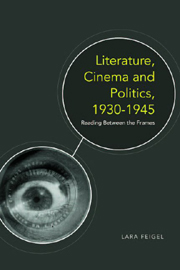Book contents
- Frontmatter
- Contents
- Acknowledgements
- List of Figures
- Introduction
- 1 Radical Cinema
- 2 Mass Observing: The 1930s Documentary Gaze
- 3 The Documentary Movement and Mass Leisure, 1930–1945
- 4 Camera Consciousness
- 5 Framing History: Virginia Woolf and the Politicisation of Aesthetics
- 6 ‘The savage and austere light of a burning world’: The Cinematic Blitz
- Afterword
- Endnotes
- Bibliography
- Index
6 - ‘The savage and austere light of a burning world’: The Cinematic Blitz
Published online by Cambridge University Press: 12 September 2012
- Frontmatter
- Contents
- Acknowledgements
- List of Figures
- Introduction
- 1 Radical Cinema
- 2 Mass Observing: The 1930s Documentary Gaze
- 3 The Documentary Movement and Mass Leisure, 1930–1945
- 4 Camera Consciousness
- 5 Framing History: Virginia Woolf and the Politicisation of Aesthetics
- 6 ‘The savage and austere light of a burning world’: The Cinematic Blitz
- Afterword
- Endnotes
- Bibliography
- Index
Summary
Fire and blackout
Stephen Spender, Henry Green William Sansom
The London Blitz brought a cinematic end to a decade of camera consciousness. When the first bombs fell on London in September 1940, the blaze of the fire and searchlights joined the flicker of the camera and the flash of history in a spectacular vision of apocalypse. Stephen Spender experienced an early raid as ‘the end I seemed now to have been awaiting all my life’, not least because the writer was now the photographer and viewer of an already photographic conflagration. In his 1945 poem ‘Abyss’, Spender positions himself as the unwilling photographer of the destruction:
When the foundations quaked and the pillars shook,
I trembled, and in the dark I felt the fear
Of the photograph my skull might take
Through the eye sockets, in one flashlit instant[.]
The camera has infiltrated the poet's brain so that even in the dark he has no escape from vision. He awaits the potentially fatal flash of the camera-like bombs.
Unsurprisingly, wartime photographers and filmmakers made the most of the inherently cinematic aspects of the Blitz. According to Virilio, the bombing raids were ‘a son-et-lumiére, a series of special effects, an atmospheric projection designed to confuse a frightened, blacked-out population’. Black-and-white photography and cinema came into their own in capturing the darkness of the blackout, punctured by the fire. Week after week, photographs in Picture Post showed London lit up against the blackout.
- Type
- Chapter
- Information
- Literature Cinema and Politics 1930–1945Reading Between the Frames, pp. 193 - 231Publisher: Edinburgh University PressPrint publication year: 2010

